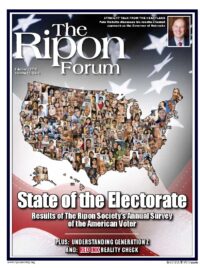
Over the past month, President Trump and lawmakers from both political parties have called for the lifting of a 2010 moratorium on earmarks in Congress as a way to help overcome political gridlock.
Earmarks were banned after members of the Tea Party and progressives gained seats in the mid-term elections by running against excessive government spending on “pork” projects, such as the Bridge to Nowhere in Alaska and the $3 million study of bear DNA in Montana.
In the face of these calls by the President and others to restore earmarks, a bipartisan group of Senators have now introduced legislation to keep the ban in place. While this debate over the future of earmarks is important and necessary, we believe it largely omits a critical function of the legislative process.
Specifically, we argue that — while far from perfect — earmarks do provide incentives to overcome collective action challenges in Congress. More importantly, earmarks — if properly overseen — provide a much more transparent and accountable system of distributing taxpayer dollars than the system of “letter-marking” that has shifted responsibility in this area from Congress to the President.
Letter-marking is a two-step process whereby a lawmaker first requests broad programmatic authority for an executive agency to use its discretion to dole out federal grants or contracts, and then writes a letter to the agency requesting funding for a project in their district.
For those not familiar with the term, letter-marking is a two-step process whereby a lawmaker first requests broad programmatic authority for an executive agency to use its discretion to dole out federal grants or contracts, and then writes a letter to the agency requesting funding for a project in their district. Our recent research on letter-marking found executive agencies and the President now have wide discretion in the allocation of projects, which represents a fundamental shift in appropriations power from the legislative to the executive branch. Despite this shift, members of Congress have not relented in the pursuit of projects for their districts. In addition to letter-marking, we have found cases where members of Congress attempt to influence the allocation of projects by agencies by modifying decision-making criteria and processes (such as cost-benefit analysis).
Additionally, the process of letter-marking is largely obfuscated and difficult for citizens to observe. Because of Congress’s exemption from the Freedom of Information Act, often the only way for citizens or researchers to obtain requests sent from members of Congress to federal agencies for projects or funding is to submit FOIA requests to each agency individually for its records of Congressional communications. The obscured nature of letter-marking allows members to achieve two goals simultaneously: working to secure projects for their districts behind the scenes, while publically advocating for deficit reduction and reduced spending.
The obscured nature of letter-marking allows members to achieve two goals simultaneously: working to secure projects for their districts behind the scenes, while publically advocating for deficit reduction and reduced spending.
The obscured nature of letter-marking allows members to achieve two goals simultaneously: working to secure projects for their districts behind the scenes, while publically advocating for deficit reduction and reduced spending.
Finally, and importantly, because agencies – rather than congressional committees or leadership — now have the power to allocate projects, there is less incentive for members of Congress to compromise on general interest legislation. Earmarks provided a solution to a critical collective action problem – namely, how to persuade lawmakers to compromise on general interest legislation that does not directly benefit their state or district. The ban on earmarks takes away one of the critical incentives (with committee assignments being the other) that congressional leaders offered lawmakers in order to win their support of legislation and loyalty to the party. Former Senate Majority Leader Trent Lott lamented the earmark ban by saying: “Trying to be a leader where you have no sticks and very few carrots is dang near impossible. Members don’t get anything from you, and leaders don’t give you anything. They don’t feel like you can reward them.”
While there is no doubt that factors such as polarization and gerrymandering have also eroded the ability of Congress to function, the loss of the “carrot” of earmarks has also significantly contributed to gridlock in the first branch. We believe the shift of Article I appropriations powers to the executive branch — coupled with the lack of transparency associated with letter-marking — make the reinstatement of earmarks the lesser of two evils. However, there are several steps that could be taken to design a system of earmarking that is more accountable to citizens (and more politically palatable to members) than in the past.
First, all earmark requests must be publically available and housed in an easily accessible database. Second, members of Congress must be held accountable for the project’s success. This could be assessed through Government Accountability Office (GAO) audits of earmark projects. Finally, members of Congress should not be able to provide earmarks to organizations or individuals who supported their campaigns. This would alleviate much of the original resistance to earmarks that was rooted in the “pay to play” scandals between members of Congress and lobbyists.
Russell W. Mills, Ph.D., and Nicole Kalaf-Hughes, Ph.D., serve as Associate Professors of Political Science at Bowling Green State University.




